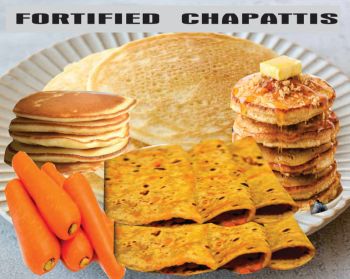Evaluation of chapattis fortified-diet with raw and fermented carrot powder in persons with type 2 diabetes: A randomized control pilot study
Abstract
Background
Diabetes is a metabolic disease that is common and growing rapidly. It is characterised by high blood sugar levels and related complications to vital organs such as the kidneys, heart, blood vessels, and eyes. The most common kind of diabetes affecting people globally is type 2 diabetes (T2D). An increasing number of people are looking at natural foods and dietary supplements to manage their T2D.
Objective
The aim of this pilot study was to assess the glycemic index, glycemic response, sensory qualities, nutritional composition, and possible antidiabetic benefits of chapattis fortified with raw and fermented carrot powder.
Methods
Seven preparations of chapattis were prepared into three variants from whole wheat flour chapattis (WWFC) as control group, raw carrot-supplemented chapattis (RCSC) with subtypes T1, T2, and T3, and fermented carrot-supplemented chapattis (FCSC) with subtypes T4, T5, and T6. The variants were provided to 11 professionally trained sensory panelists for organoleptic evaluation. The chapattis subtype with the best organoleptic properties together with the WWFC were then given randomly to a group of 30 persons with T2D respectively to see how their blood sugar levels were affected over a period of 4 weeks.
Results The panelist adjudged RCSC (T2) and FCSC (T5) as the best organoleptically. The randomised control investigation demonstrated that the fasting blood glucose levels for WWFC, RCSC, and FCSC decreased (P<0.05) significantly by 6.42%, 7.24%, and 12.75%, respectively. However, there was no significant different in the fasting blood sugar between the WWFC and RCSC. As for the glycemic load values of WWC, RCSC, and FCSC, which were 21, 14, and 13, respectively, there was no statistically significant difference between RCSC and FCSC, suggesting that both types of chapattis could help T2D patients regulate their blood sugar levels. The most significant changes were consistently shown by the FCSC: 17.50% reduction in random blood sugar (p = 0.03), 21.85% reduction in serum low-density lipoprotein (p = 0.051), 16.67% increase in serum HDL (p = 0.01), 11.09% decrease in serum cholesterol (p = 0.02), and 12.575% reduction in serum triglycerides (p = 0.048).
Conclusions
A beneficial dietary intervention for people with T2D may involve mixing fermented carrot powder into regular chapattis. These findings contribute to the growing body of evidence in favour of using natural food-based treatments for the management of diabetes.

Authors retain all copyrights. In making a submission to World Nutrition, they are certifying that all material is theirs except quotations, as indicated, and that they have obtained permission for any photos, tables, or graphics taken from other publications or websites.




